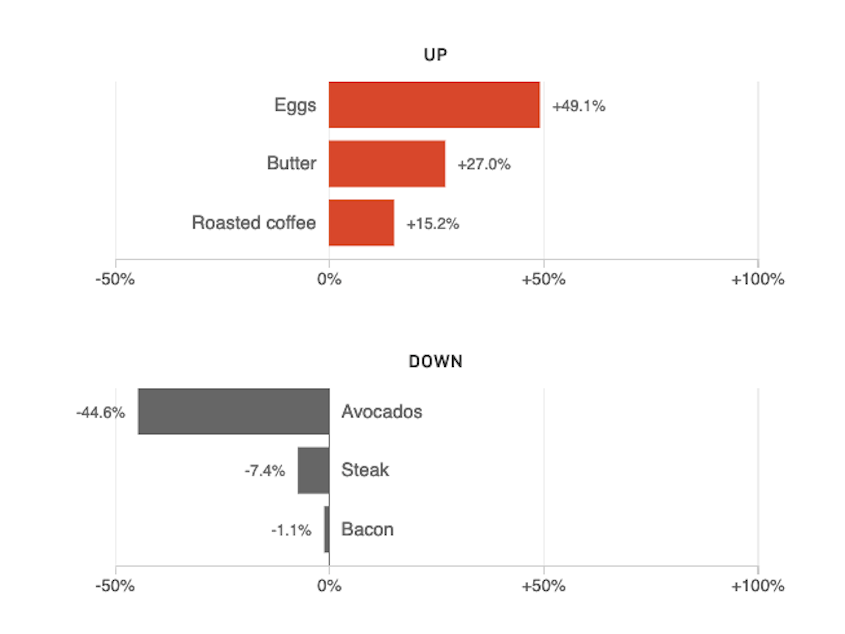How life got pricier (and, yes, cheaper!) this year — in 7 charts

Boy, have we talked a lot about inflation this year. The rising cost of food, pricier oil, supply-chain turmoil, Russia's war in Ukraine, growing wages and a lingering labor shortage all contributed to higher prices that touched almost every part of our lives.
Here are some of the ways our lives got pricier and cheaper (it wasn't all bad news!) in 2022.
Groceries
Breakfast – the most important meal of the day (supposedly) – has gotten quite expensive. Eggs were an inflation high-flyer, largely because of a historic bird-flu outbreak. Lower dairy production pushed up butter and milk prices. The war in grain-producing Ukraine boosted bread prices. At least bacon and avocados are giving us a break. So is beef. It's What's For Dinner—and breakfast?
Going out & staying in
Sponsored
After cooped-up 2020 and 2021, this was the comeback year. Movie theaters and concert venues filled up. Big demand plus hiring difficulties and higher food costs pushed up menu prices. Meanwhile, after massive supply-chain backlogs of home electronics, stores were finally overstocked – just when people kind of didn't need any more, giving us some of the biggest discounts around.
Adulting
Yikes. Electricity and heating oil also got pricier. Any pandemic-era savings petered out. We started charging more to our credit cards. The end of the home-buying bonanza did slice home prices (silver lining!), but mainly because mortgage rates nearly doubled (very dark cloud).
Work things
This was the year of raises that were quickly eaten by inflation. A pandemic-fueled unionization wave continued, though it began to slow. And forget "quiet quitting" – people actually quit jobs and took new (better?) ones at such a rapid pace that nationwide productivity took a hit as workers settled in to new positions (at least that's the most optimistic explanation).
Sponsored
Going places
Ahoy savers! Sure, planes, hotels and automobiles (fuel and maintenance) got more expensive, but have you considered an ocean liner? It may not take you many places in the U.S., but at least the CDC is sort of on board now?
The markets
It was back to the future for markets. Russia's war in Ukraine disrupted energy trade, sending global coal use toward record highs. Oil companies had a banner year thanks to pumped-up prices. Meanwhile, the metaverse and the cryptoverse got a major reality check. The tech-heavy Nasdaq exchange lost nearly a third of its value.
Big picture
Sponsored
Seen this way, 2022 wasn't a terrible year overall. The economy grew, supply chain pressures eased and fewer people are unemployed. As long as you don't need to buy anything or borrow any money, things are looking pretty good!
Methodology
Calculations rely on the latest data. Most compared November 2022 to November 2021. Avocado prices are from December. Union data are from October. Stock prices and other markets data are from Dec. 21, compared to a year earlier. Bitcoin is measured against the U.S. dollar. The dollar value is measured against a basket of currencies using the U.S. Dollar Index.
Sources:
Bureau of Labor Statistics (Consumer Price Index, Unemployment rate, Wage growth, Job openings, Productivity)
Sponsored
Federal Reserve Bank of New York (Global Supply Chain Pressure Index, Household debt and credit report)
Federal Reserve Bank of St. Louis (GDP, Personal savings)
Agronometrics (Avocado prices)
National Labor Relations Board (Union filings)
Challenger, Gray & Christmas (Job cuts)
Sponsored
National Association of Realtors (Existing-home sales)
Trading Economics (Chicago lumber futures, Newcastle coal futures)
[Copyright 2022 NPR]



